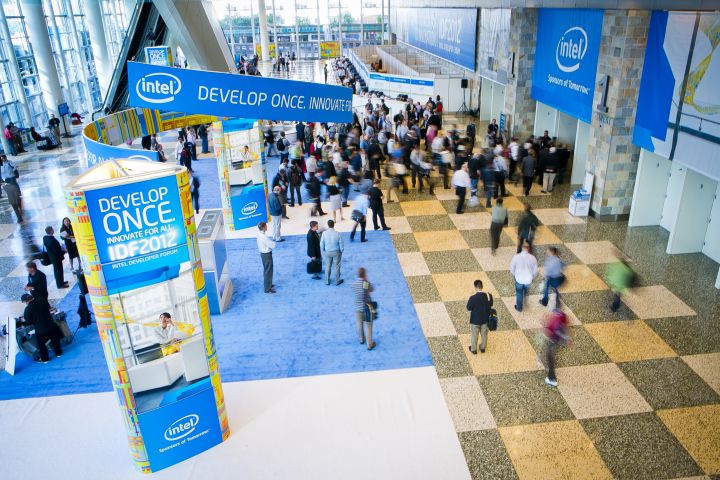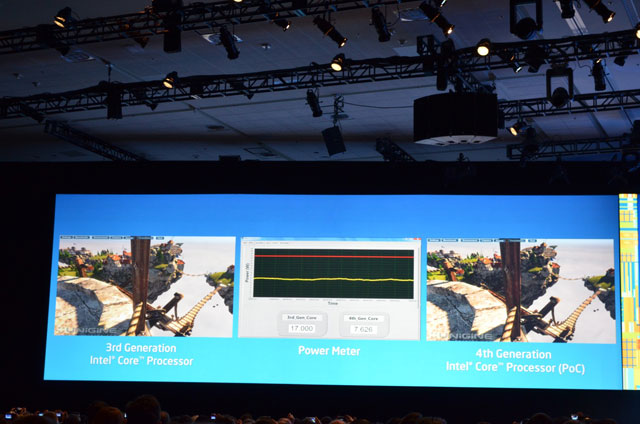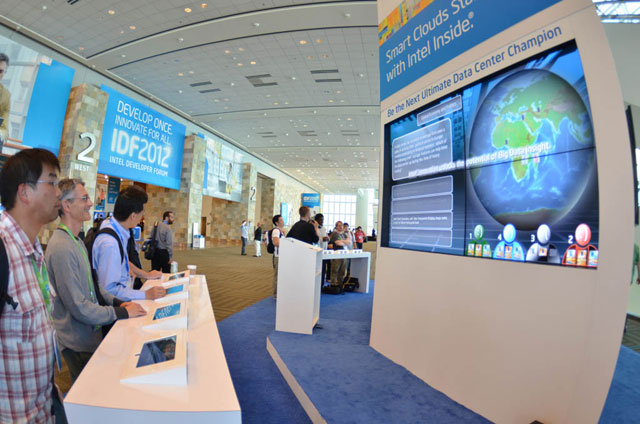The most important thing about the Intel Developer Forum 2012

Autumn came,
One of the central themes of the Forum was the fourth generation of Intel Core processors based on the 22-nanometer Haswell microarchitecture, which will appear on the market in 2013. The main advantages of these processors are significantly increased performance with so much reduced power consumption. Haswell processors will support Intel HD graphics systems, new instruction sets for faster performance and encryption, new hardware protection features, and new low-power modes. In general, the energy efficiency of the entire platform compared to Sandy Bridge will increase by 20 times. Intel Product Director Dadi Perlmutter in his speech gave a concrete example: a benchmark running on the 3rd and 4th generations of Intel Core processors. The graph shows the power consumption of both chips with equal performance - 17W for Ivy Bridge versus 7.5W for Haswell (in the photo below).

Together with Intel Core, the Intel Atom processor line (codenamed Clover Trail) will be updated, which will be presented in the near future. It is a new system-on-chip (SoC), created specifically for Windows 8. Clover Trail processors are based on 32-nanometer manufacturing technology, designed for small tablet PCs and mobile PCs with a transformable design, provide a long time and support instant device access technology.
')
The update is waiting for the server series and Intel Xeon . In 2013, the production of Xeon processors of the E5 family, codenamed Ivy Bridge-EP, will be launched, based on a 22-nm manufacturing process that includes the world's first three-dimensional Tri-Gate transistors. At the same time, there will be a new generation of Intel Xeon processors of the E7 family, codenamed Ivy Bridge-EX, which will also be created on the basis of the 22-nm manufacturing process. The benefits of these processor families include increased performance, new reliability features, and hardware protection features. A new Xeon Phi coprocessor is also introduced - it is in Dadi’s left (right of us) hand.

One of the latest trends in solutions for “digital habitat” is the creation of “susceptible”, traditional for humans, interfaces for user interaction with computer devices. In the same speech, Dadi Perlmutter called on the developer community to work more actively with Intel to create this kind of interaction interfaces using the beta version of the Intel Perceptual Computing Software Development Kit . The new kit will be released at the beginning of the next quarter and will allow developers of hardware and software solutions to add gesture and voice recognition features to existing and future Ultrabook devices and PCs based on Intel processors.
In our daily life, including through the efforts of Intel, the role of intelligent devices that can interact and exchange data with each other is growing. In this “global computer network of things”, order is needed — for this, Intel has created the Intel Intelligent Systems Framework , which will include a whole set of compatible solutions designed to ensure consistent and scalable communication, controllability and security of various devices. The Intel Intelligent Systems Framework includes several basic components developed by Intel and its ecosystem partners. The system uses Intel Xeon, 2nd and 3rd generation Intel Core processors with Intel vPro TM technology and Intel Atom processors.
Good news for developers - the Forum announced the launch of the Intel Developer Zone, a program that will become a single resource for developers and companies to access all the necessary tools, communities and resources to communicate with colleagues. Its main components are:
- Resource Development. Software tools, training programs, developer guides, code samples, and professional support.
- Resources for business. New features for distribution and software sales will be available within the Intel AppUp Center.
- Active communities. With the help of the Intel Developer Zone, developers can chat with leading industry experts, including Intel experts.

The fashionable “cloud” theme has not remained unaffected. Intel announced the launch of the new Intel Cloud Finder program, designed to speed up the search and selection of cloud service providers. Despite the fact that many companies are ready to implement cloud computing technologies, choosing the optimal service provider can be quite difficult. Intel Cloud Finder simplifies this process with online tools and resources that help you speed up the search and share information on best practices and strategies for deploying public cloud environments.
Intel Developer Forum 2012 has already been completed, and experts have scattered back to their offices and headquarters. But, what is important for us, after the Forum, there were so many new topics that they would be enough for the next six months - just before the new IDF, which will be held in Beijing in April 2013.
Source: https://habr.com/ru/post/151730/
All Articles